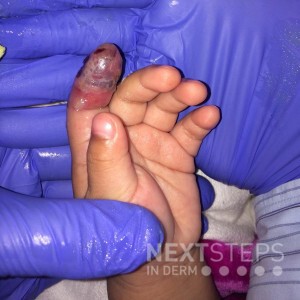
The correct answer is B. Acyclovir.
The most appropriate treatment of herpetic whitlow is acyclovir. This question requires the examinee to clinically identify herpetic whitlow by the presence of clustered vesicles with surrounding erythema and edema located on a distal digit. Herpetic whitlow, caused by direct inoculation of the digital pulp by herpes simplex virus (HSV) 1 or 2, should be treated with acyclovir (choice 2). Incision and drainage (choice 1) may be required to treat a digital pulp abscess (felon), which would manifest with an erythematous fluctuant nodule lacking clustered vesicles. Foscarnet (choice 3) is used to treat acyclovir-resistant HSV infections, which typically occur in immunosuppressed patients. Dicloxacillin (choice 4) treats streptococcal and staphylococcal infections. On the differential diagnosis for herpetic whitlow is blistering distal dactylitis, usually caused by group A Streptococcus and appropriately treated with dicloxacillin. However, blistering distal dactylitis presents with a single vesicle or bulla, rather than clustered vesicles, at the palmar fingertip. Clindamycin (choice 5) is used to treat methicillin-resistant Staphylococcus aureus infections as well as bacterial toxin-mediated diseases (staphylococcal scalded skin syndrome, toxic shock syndrome), which would not present with clustered vesicles on a digit.
References: Fatahzadeh M, Schwartz RA. Human herpes simplex virus infections: epidemiology, pathogenesis, symptomatology, diagnosis, and management. J Am Acad Dermatol. 2007 Nov;57(5):737-63.
